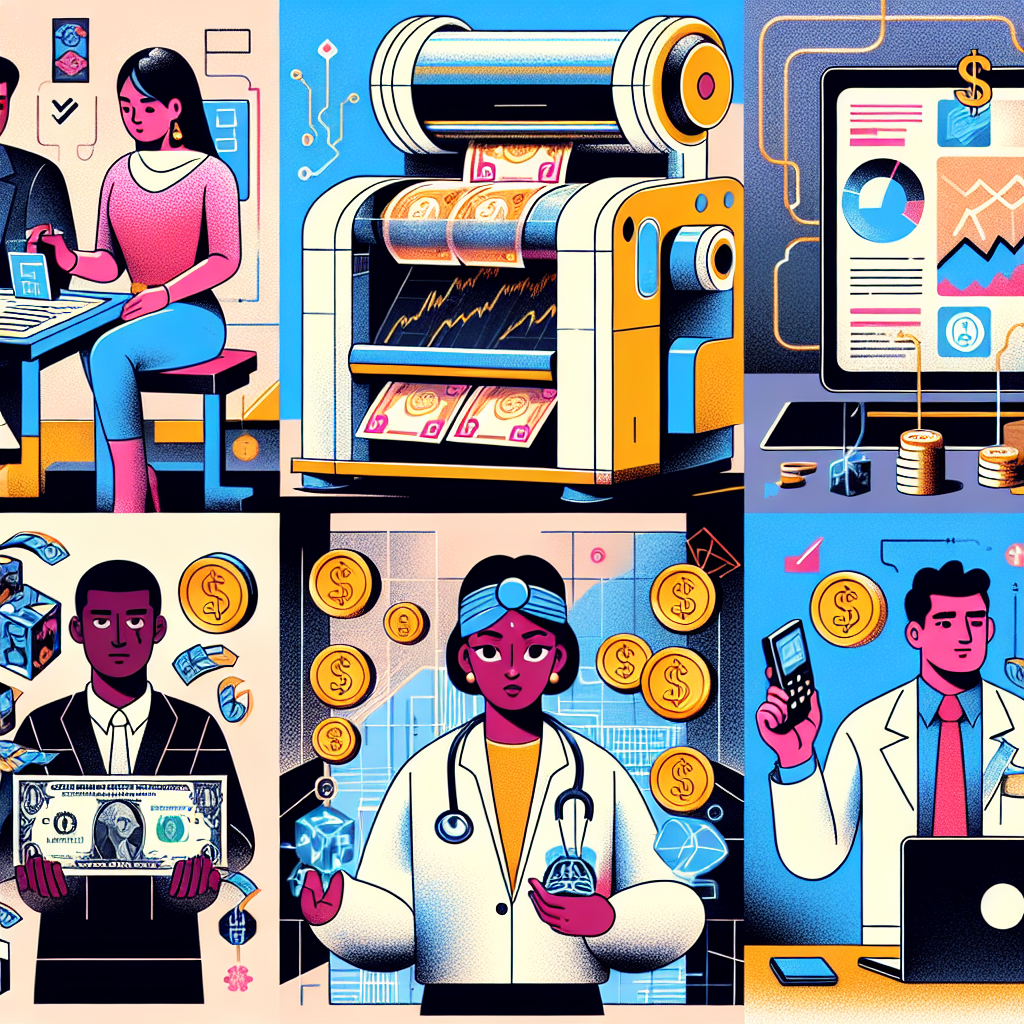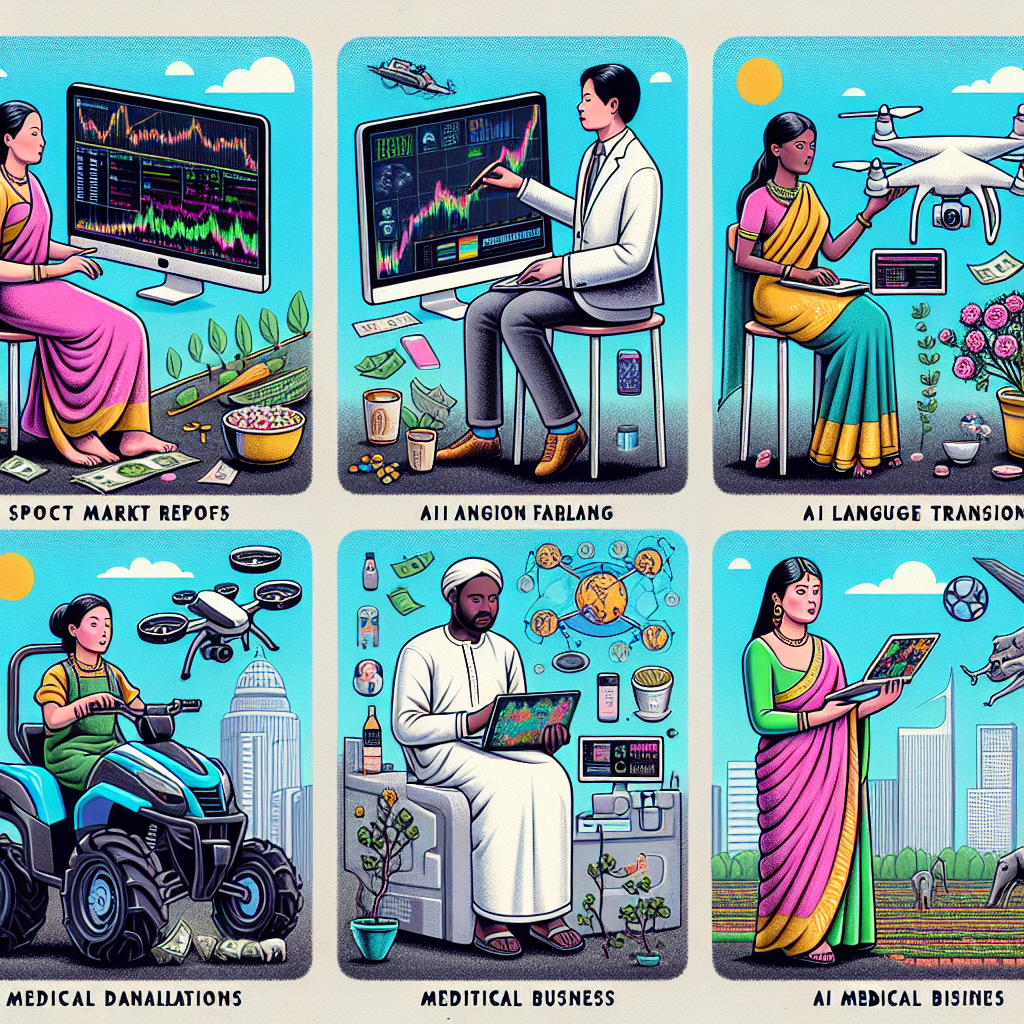-
Table of Contents
“Unlocking Profit: The Unconventional AI Gold Rush”
Introduction
In recent years, the rapid advancement of artificial intelligence has opened up a plethora of unconventional avenues for generating income. While traditional applications of AI have focused on enhancing productivity and efficiency, some enterprising individuals and businesses have ventured into more peculiar territories, leveraging AI in unexpected ways to create financial opportunities. From AI-generated art fetching high prices at auctions to algorithm-driven trading strategies that outpace human counterparts, these innovative approaches highlight the diverse potential of AI in the modern economy. This exploration delves into five of the most unusual methods by which people are harnessing the power of AI to print money, showcasing the creativity and ingenuity that define this technological frontier.
Digital Artistry: How AI-Generated Art Is Becoming A Lucrative Investment
In recent years, the intersection of artificial intelligence and digital artistry has opened up a plethora of opportunities for creative expression and financial gain. As AI technology continues to evolve, it is increasingly being harnessed to generate unique pieces of art that captivate collectors and investors alike. This burgeoning field of AI-generated art is not only redefining the boundaries of creativity but also becoming a lucrative investment avenue for those willing to explore its potential.
To begin with, AI-generated art is created using algorithms that can analyze vast datasets of existing artworks, learning styles, techniques, and patterns. These algorithms then produce original pieces that often blend traditional artistic elements with innovative digital aesthetics. The result is a new form of art that challenges conventional notions of authorship and creativity. As these AI-generated artworks gain recognition, they are increasingly being showcased in galleries and exhibitions, attracting the attention of art enthusiasts and investors.
Moreover, the rise of blockchain technology has further propelled the market for AI-generated art. Non-fungible tokens (NFTs) have emerged as a revolutionary way to authenticate and trade digital art, providing a secure and transparent platform for transactions. NFTs have enabled artists and collectors to buy, sell, and trade digital artworks with ease, ensuring provenance and ownership rights. This has led to a surge in demand for AI-generated art, as investors seek to capitalize on the growing popularity of NFTs and the unique value proposition they offer.
In addition to the technological advancements driving this trend, the appeal of AI-generated art also lies in its ability to push creative boundaries. Artists and technologists are collaborating to explore new artistic possibilities, using AI to create works that are not only visually stunning but also conceptually intriguing. This fusion of art and technology has given rise to a new genre of art that resonates with a tech-savvy audience, eager to invest in pieces that reflect the zeitgeist of the digital age.
Furthermore, the democratization of art creation through AI has opened up opportunities for a wider range of artists to enter the market. With AI tools becoming more accessible, artists without formal training or traditional skills can now produce high-quality digital art. This has led to a more diverse and inclusive art market, where emerging artists can gain recognition and financial success alongside established names. As a result, investors are increasingly looking to AI-generated art as a way to discover and support new talent.
Finally, the speculative nature of the art market has also contributed to the financial allure of AI-generated art. As with any emerging market, there is a degree of uncertainty and risk involved, but this also presents the potential for significant returns. Investors who are willing to embrace the unpredictability of AI-generated art may find themselves reaping substantial rewards as the market continues to mature and evolve.
In conclusion, the convergence of AI technology and digital artistry is transforming the art world, offering new opportunities for creative expression and financial investment. As AI-generated art gains traction, it is becoming an increasingly attractive option for investors seeking to diversify their portfolios and capitalize on the digital revolution. With its unique blend of innovation, accessibility, and speculative potential, AI-generated art is poised to become a significant player in the global art market, redefining the way we perceive and invest in art.
Automated Trading: The Rise Of AI-Driven Stock Market Strategies

In recent years, the financial landscape has been dramatically transformed by the advent of artificial intelligence, particularly in the realm of automated trading. This technological evolution has given rise to AI-driven stock market strategies that are not only reshaping traditional trading practices but also offering novel ways for individuals and institutions to generate substantial profits. As we delve into this intriguing development, it becomes evident that AI’s role in the stock market is multifaceted, encompassing a range of innovative applications that are, in some cases, quite unconventional.
To begin with, one of the most prominent ways AI is being utilized in stock trading is through algorithmic trading systems. These systems leverage complex algorithms to analyze vast amounts of market data at speeds unattainable by human traders. By identifying patterns and trends, AI can execute trades with precision and efficiency, often capitalizing on minute price discrepancies that occur within fractions of a second. This high-frequency trading approach has become a cornerstone of modern financial markets, allowing traders to maximize profits while minimizing risks.
Moreover, AI’s ability to process and interpret unstructured data, such as news articles and social media posts, has opened new avenues for market analysis. Sentiment analysis, for instance, enables AI systems to gauge public sentiment and predict market movements based on the collective mood of investors. This capability is particularly valuable in today’s fast-paced digital world, where information spreads rapidly and can significantly impact stock prices. By incorporating sentiment analysis into their trading strategies, investors can gain a competitive edge, making more informed decisions that align with market sentiment.
In addition to these conventional applications, AI is also being employed in more unconventional ways to generate profits. For example, some traders are using AI to develop predictive models that forecast future stock prices based on historical data and machine learning techniques. These models can identify potential investment opportunities that may not be immediately apparent to human analysts, thus providing a unique advantage in the competitive world of stock trading.
Furthermore, AI-driven trading bots have gained popularity among individual investors seeking to automate their trading activities. These bots can be programmed to execute trades based on predefined criteria, such as technical indicators or market conditions. By removing the emotional component from trading decisions, AI-driven bots can help investors maintain discipline and consistency, ultimately leading to more profitable outcomes.
Finally, the integration of AI with blockchain technology has given rise to decentralized finance (DeFi) platforms that offer innovative financial products and services. These platforms leverage smart contracts and AI algorithms to facilitate automated trading and investment strategies, providing users with new opportunities to earn returns on their assets. As DeFi continues to gain traction, it is likely that AI will play an increasingly important role in shaping the future of finance.
In conclusion, the rise of AI-driven stock market strategies represents a significant shift in the way trading is conducted. From algorithmic trading and sentiment analysis to predictive modeling and trading bots, AI is being harnessed in a variety of ways to print money in the financial markets. As technology continues to evolve, it is clear that AI will remain a key driver of innovation in the world of finance, offering both challenges and opportunities for traders and investors alike.
Content Creation: AI-Powered Tools Revolutionizing The Blogging Industry
In recent years, the blogging industry has witnessed a transformative shift, largely driven by the advent of artificial intelligence (AI). As content creators strive to keep up with the ever-evolving digital landscape, AI-powered tools have emerged as invaluable assets, offering innovative solutions to enhance productivity and creativity. These tools are not only streamlining the content creation process but are also enabling bloggers to monetize their platforms in unprecedented ways. By leveraging AI, bloggers are discovering unique methods to generate income, thereby revolutionizing the industry.
To begin with, AI-driven content generation tools are at the forefront of this transformation. These tools can produce high-quality articles, blog posts, and other written content with minimal human intervention. By analyzing vast amounts of data and understanding language patterns, AI can generate content that is not only coherent but also tailored to specific audiences. This capability allows bloggers to maintain a consistent posting schedule, thereby increasing their visibility and engagement. As a result, bloggers can attract more traffic to their sites, which in turn enhances their monetization potential through advertising and affiliate marketing.
Moreover, AI is playing a crucial role in optimizing content for search engines. Search engine optimization (SEO) is a critical component of successful blogging, and AI tools are now capable of analyzing search trends, keywords, and user behavior to provide actionable insights. By utilizing these insights, bloggers can create content that ranks higher in search engine results, driving more organic traffic to their sites. This increased visibility not only boosts ad revenue but also opens up opportunities for sponsored content and partnerships with brands seeking to reach a wider audience.
In addition to content generation and optimization, AI is also revolutionizing the way bloggers engage with their audiences. Chatbots and virtual assistants, powered by AI, are being integrated into blogs to provide real-time interaction with readers. These tools can answer questions, provide recommendations, and even assist with purchases, creating a more interactive and personalized experience for users. This enhanced engagement can lead to higher conversion rates, as readers are more likely to become loyal followers or customers when they feel a personal connection to the content.
Furthermore, AI is enabling bloggers to diversify their content offerings through multimedia integration. AI-powered tools can assist in creating and editing videos, podcasts, and graphics, allowing bloggers to expand their reach beyond traditional written content. By offering a variety of content formats, bloggers can cater to different audience preferences and increase their chances of monetization through platforms like YouTube and Patreon. This diversification not only attracts a broader audience but also provides multiple revenue streams, reducing reliance on a single source of income.
Finally, AI is facilitating data-driven decision-making for bloggers. By analyzing user data and content performance metrics, AI tools can provide insights into what types of content resonate most with audiences. This information allows bloggers to refine their strategies, focusing on content that is more likely to generate engagement and revenue. As a result, bloggers can make informed decisions about where to invest their time and resources, ultimately leading to more effective monetization strategies.
In conclusion, AI-powered tools are revolutionizing the blogging industry by offering innovative solutions for content creation, optimization, engagement, diversification, and data analysis. These tools are enabling bloggers to print money in ways that were previously unimaginable, transforming the industry and setting new standards for success. As AI technology continues to evolve, it is likely that its impact on the blogging industry will only grow, offering even more opportunities for content creators to thrive in the digital age.
Conclusion
The exploration of unconventional methods for leveraging AI to generate income highlights the innovative and sometimes eccentric approaches individuals are taking in the digital economy. From creating AI-generated art and music to developing automated trading algorithms and personalized content creation, these methods demonstrate the versatility and potential of AI in diverse fields. Additionally, the use of AI in niche markets, such as virtual influencers and AI-driven gaming, underscores the expanding boundaries of technology in monetization strategies. While these approaches may seem unusual, they reflect a broader trend of integrating AI into creative and financial processes, ultimately reshaping traditional business models and opening new avenues for economic opportunity.
